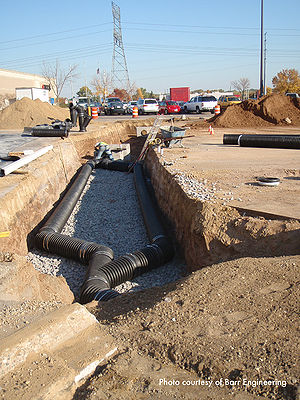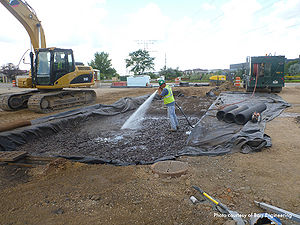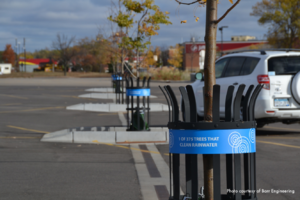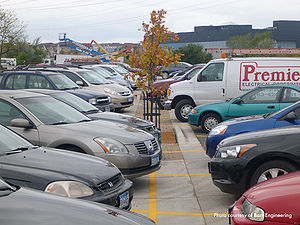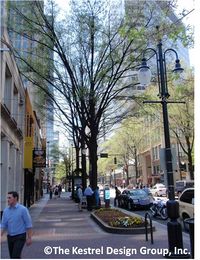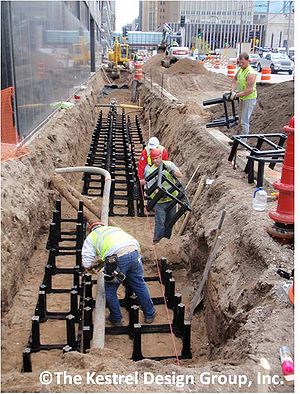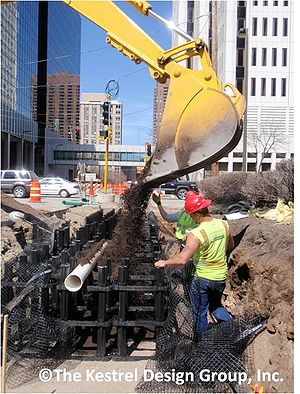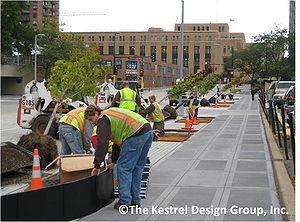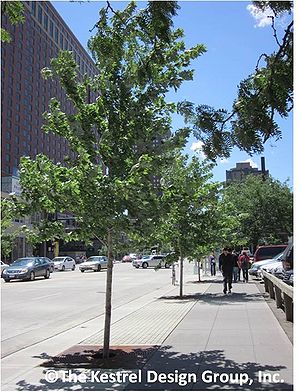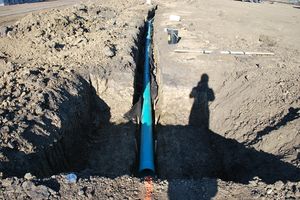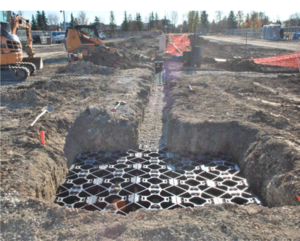
Case studies for tree trenches and tree boxes
Contents
- 1 Maplewood Mall, Maplewood Minnesota
- 2 Central Corridor Green Line Integrated Tree Trench System, St. Paul and Minneapolis, Minnesota
- 3 Tryon Street Mall Trees, Charlotte, NC
- 4 MARQ2, Minneapolis, Minnesota
- 5 Mills Woods Sports Site, Edmonton, Alberta
- 6 Garrison Concourse Overlook Site Restoration and ADA Improvements, City of Garrison, Minnesota
- 7 Related pages
Maplewood Mall, Maplewood Minnesota
The Kohlman Lake TMDL (Total Maximum Daily Load) report calls for a 22 percent reduction in watershed loading of phosphorus. In response to the TMDL, the Maplewood Mall recently underwent a comprehensive redesign of its 35 acre parking lot. The four-phase construction process of this redesign took place between 2009 and 2012. This parking lot was designed by Barr Engineering Company on behalf of the Ramsey-Washington Metro Watershed District (who sponsored the project) and Simon Property Group (who owns Maplewood Mall). This redesign was completed with the intent of capturing one inch of runoff from 90 percent of the parking lot area, while reducing at least 90 percent of the sediment load and 60 percent of the phosphorus load leaving the site.
To help meet the proposed stormwater goals, this project included 375 trees planted across the project site. Two hundred trees were placed in tree trenches and 175 trees were placed in rainwater gardens. This case study will focus on the planting methods for the trees planted within the tree trenches.
Each tree placed in a tree trench was planted using a Stockholm Tree Trench Method for Stormwater. The Stockholm Tree Trench Method uses angular granite rock to bear the load of the pavement profile and vehicular traffic above. The void space between the angular granite was filled with soil, which is washed into the angular granite. The soil does not need to be compacted to support loads. This non-compacted soil and remaining void space between the angular granite are available for use by trees as both a growing medium and space for gaseous exchange to and from the roots.
Approximately 820 cubic feet of soil/angular granite and clear angular granite was provided per tree on average. The average installed cost per tree using this method was $18,000. This cost includes soil treatment and all other aspects of the tree trench installation such as storm sewers, asphalt pavement profile, concrete curb, tree grates, cages, etc. The trees received supplemental watering via 15 gallon capacity gator bags for the first two years of growth. Following the two-year establishment period, the trees will only receive water from above and below during rainfall events. At the time of the writing of this case study, October 2013, the planted trees are in good to excellent condition. When initially planted, the tree canopy covered less than 1 percent of the site. After 20 years growth, the trees are projected to cover 17 percent of the site with canopy.
The designer stated that in future work using similar planting techniques they would modify their maintenance protocol to include biannual fertilization at the tree root ball for the first two years of growth (per the advice from the street tree specialists in Stockholm, Sweden) and use larger capacity gator bags to better facilitate watering during the first two years of growth.
The stormwater goals of this project were to
- determine the effectiveness of the tree trench systems in reducing pollutant loading and volume;
- determine the effectiveness of the overall project in reducing pollutant loading and volume; and
- monitor the use of the cistern during the first full season of its operation in order to determine water use and the frequency of cleaning required in the future.
In 2011 and 2012, Barr Engineering Company worked with the Ramsey-Washington Metro Watershed District to develop a monitoring plan and to create an XPSWMM model to determine the reduction in runoff volume as a result of this project.
The following activities were planned for 2013.
- monitor rain gage levels;
- monitor the east and south locations for water quality and quantity from post-project conditions;
- record water levels in the entrance cistern while it is online;
- monitor tree grove level loggers;
- model (using rain gage data) to determine the reduction in runoff volume due to project;
- analyze water quality data and tree grove level logging data; and
- develop a monitoring report to assess the effectiveness of the project.
At the time of this case study, the analysis of the data was still being completed and the monitoring report had not been released.
Project Summary
- Owners: Ramsey-Washington Metro Watershed District (project sponsors) and Simon Property Group (owners of Maplewood Mall)
- Designers: Barr Engineering Company
- Year of completion: 2012
- Tree Planting Method: Stockholm Soil Trench Method
- Tree Species Used in Planting Method: Discovery Elm (Ulmus davidiana (Discovery)), Skyline Honey Locust (Gleditsia tricanthos var. inermis (Skyline)), Espresso Kentucky Coffeetree (Gymnocladus dioicus (Espresso)), Common Hackberry (Celtis occidentalis), and Swamp White Oak (Quercus bicolor)
- Number of trees in Planting Method: 200
- Approximate Installed Cost Per Tree: $18,000
- Stormwater Goals: capturing one inch of runoff from 90 percent of the parking lot area, while reducing at least 90 percent of the sediment load and 60 percent of the phosphorous load leaving the site.
- Is the Site Accessible: Yes
For more information
- Ramsey-Washington Metro Watershed District: Maplewood Mall Retrofit
- Retrofitting a Major Retail Mall for Stormwater Volume Reduction
- Maplewood Mall Tree Trenches – Design and Impact on Stormwater, Erin Anderson Wenz, P.E., Barr Engineering Company
- Maplewood Mall Rainwater Runoff Retrofit Project
Central Corridor Green Line Integrated Tree Trench System, St. Paul and Minneapolis, Minnesota
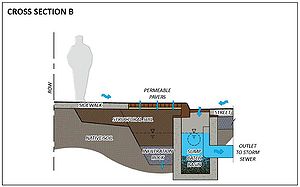
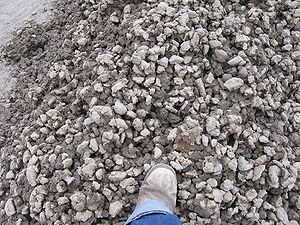

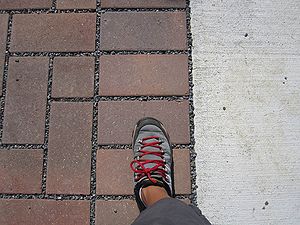
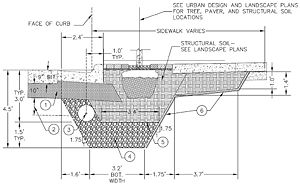
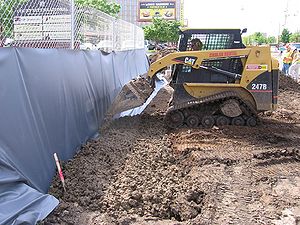
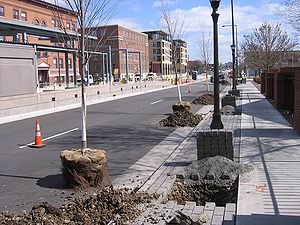
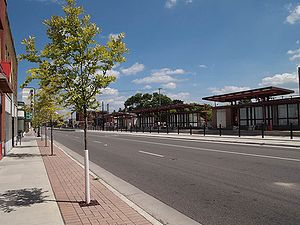
The Central Corridor Light Rail Transit (LRT) line is located within a highly-urbanized and heavily-paved corridor connecting downtown St. Paul and downtown Minneapolis. This corridor is made up of 111 acres of impervious surface. The stormwater runoff from the impervious surfaces ultimately drains to the Mississippi River via the municipal storm drain system and carries both sediment and pollutant loads to the river. Portions of the river are impaired for turbidity, nutrients, and bacteria.
As this project is located within the jurisdiction of the Capitol Region Watershed District (CRWD), it was required to comply with the CRWD's rules for stormwater management. These rules require that the site capture and retain the first inch of rainfall on site.
Four different green infrastructure practices (tree trench, underground infiltration trench, rain garden, stormwater planter) were used in conjunction to help meet the requirements outlined by CRWD, but this case study focus on the integrated tree trench systems. These systems stretch out along both sides of the corridor for over five miles of the LRT corridor. The tree trench systems are approximately 10 feet wide, with a 3 foot deep profile of CU structural soil and 1.5 feet of clear aggregate below that. These trenches provide approximately 792,000 cubic feet of CU structural soil in total for the project (approximately 634 cubic feet of CU structural soil per tree).
These tree trench systems are layered systems of trees, porous pavers, CU Structural Soil, drainage rock, and a 12 inch perforated PVC pipe that directs runoff from the street into the clear rock in the integrated tree trench systems. Where possible and appropriate, these systems are paired with existing soils with high infiltration rates. In addition to the structural components mentioned above, approximately 1,250 new trees have been planted within the integrated tree trenches. The total bid for the integrated tree trench system was $3.29 million (approximately $2,632 per tree). Please note that this bid was lump-sum and is likely low in regard to final costs. The engineer's estimate for the system was approximately $6.0 million (approximately $4,800 per tree).
The goals of this green infrastructure project, including the integrated tree trench systems, are
- treating stormwater runoff to remove sediments and other pollutants;
- reducing the quantity and rate of stormwater runoff entering the Mississippi River;
- infiltrating significant portions of the street and sidewalk runoff;
- increasing the amount of pervious surface in the right of way;
- providing a non-irrigated water source to the proposed trees; and
- enhancing livability/beauty of the corridor with streetscape enhancements and plantings.
It is estimated that the green infrastructure practices will reduce runoff volume by 3 acre feet per storm event and 102 acre-feet annually (which includes total storage volume within the tree trench systems, pavers, and CU Soils plus an estimated 0.15 inch reduction per square foot of canopy for a 20-year-old tree for each species). Estimated reductions in pollutants are 83 pounds for phosphorus and 15,134 pounds for TSS.
Monitoring occurs along the integrated tree trench systems and includes
- collection of water level and drawdown information with pressure transducer;
- use of temperature sensors 1 and 2.5 feet below the pavers;
- use of watermark moisture sensors at 0.5. 1.5. 2.0. and 3.0 foot depths (electrical resistance granular matrix sensor); and
- use of a watermark Monitor Data Logger.
Project Summary
- Owners: The Metropolitan Council
- Designers: AECOM, Kimley-Horn, HZ United
- Year of completion: 2013
- Tree Planting Method: Integrated tree trench system using CU structural soil and drainage rock.
- Sample of Tree Species Used in Planting Method: Armstrong Red Maple (Acer Rubrum (Armstrong)), Autumn Spire Red Maple (Acer Ruburm (Autumn Spire)), Sienna Glen Maple (Acer fremanii (Sienna)), Sensation Maple (Acer negundo (Sensation)), Skyline Honeylocust (Gleditsia tricanthos var. inermis (Skyline)), Princeton Sentry Ginkgo (Ginkgo biloba (Princeton Sentry)), Kentucky Coffee Tree (Gymnocladus dioicus), Spring Snow Crabapple (Malus x (Spring Snow)), Swamp White Oak (Quercus bicolor), Ivory Silk Lilac (Syringa reticulate (Ivory Silk)), Boulevard Linden (Tilia americana (Boulevard)), Redmond Linden (Tilia americana (Redmond)), Cathedral Elm (Ulmus (Cathedral)), Discovery Elm (Ulmus davidiana (Discovery)), Valley Forge Elm (Ulmus Americana (Valley Forge)), Princeton Elm (Ulmus Americana (Princeton)), Accolade Elm (Ulmus x Morton (Accolade)), Regal Prince Oak (Quercus x robar (Long)).
- Number of trees in Planting Method: 1,250
- Approximate Installed Cost Per Tree: $2,632-$4,800, estimated
- Stormwater Goals: Retain the 1-inch rainfall on site
- Is the Site Accessible: Yes
For more information, see:
Tryon Street Mall Trees, Charlotte, NC
Planted in 1985, the Tryon Street Mall Trees are some of the oldest trees planted using suspended pavement. The pavement around the trees is held slightly above the soil by 3 foot tall underground pillars so that the soil under the pavement is not compacted beyond root-limiting densities by the pavement loads. In 2013, the willow oaks planted had an average diameter at breast height of 18 inches and an average height of 71 feet (Smiley, 2013). In addition to growing big trees, the system modeled a 10 percent reduction in peak flows (peak storm event) to the City’s stormwater system (EPA, 2013). As of 2013, almost 30 years after planting, the trees are flourishing.
Project Summary
- Designers: Don McSween and Tom Perry
- Year of completion: 1985
- Tree Planting Method: Suspended pavement
- Tree Species Used in Planting Method: Willow Oak (Quercus phellos)
- Number of trees in Planting Method: 154
- Cubic feet of soil per tree: 700 c.f. per tree, shared
- Is the Site Publicly Accessible: Yes
MARQ2, Minneapolis, Minnesota
The MARQ2 project (Marquette Ave and 2nd Ave Busways) originated in response to the Minneapolis Ten Year Transportation Plan, to improve transit service by redefining lanes, lane widths, and sidewalk zones and widths. Stakeholders requested that healthy trees be part of the project.
To maximize the trees’ health, lifespan, as well as maximize stormwater and other ecological services, the designers maximized rootable soil volume for each tree using Silva Cells, a proprietary soil cell system that supports suspended pavement. Soil cells are modular structures that provide uncompacted soil volumes under paved surfaces and can support up to HS20 loading (US Standard Bridge Loading), making it possible to provide urban trees with large soil volumes even in urban areas with little open space. The uncompacted soil volume in soil cells can also be used for stormwater treatment, creating a bioretention system under paved surfaces. Using structural cells with bioretention soil, stormwater becomes an asset as a way to water the trees. The trees in turn will help cleanse and abstract storm water runoff.
The trees and soil cells in this project collect runoff from the sidewalks along 2 of Minneapolis’ main downtown streets (Marquette and 2nd Avenues) through pervious pavers that drain into the underlying structural cells. One of the soil cell groups also collects roof runoff from adjacent building scuppers.
While the amount of runoff treated per tree varies from block to block and from tree to tree, on average, each tree pit collects runoff from about a 300 square foot watershed. With 167 trees, this adds up to an estimated 50,118 square feet or 1.15 acres of sidewalk runoff captured. The loam soil in the structural cells has enough capacity to capture runoff from a 1 inch rain event from 5 times as much impervious surface as it currently captures. In other words, the soil in the structural cells has capacity to capture 1 inch of rain from 5.75 acres of impervious surface. The City of Minneapolis is reserving this extra soil stormwater holding and infiltration capacity for future routing of street runoff to the cells. As trees grow larger, they will also contribute to stormwater capture through interception and evapotranspiration.
Project Summary
- Owners:City of Minneapolis
- Designers: Short Elliott Hendrickson Inc. and URS Corporation
- Year of completion: 2009
- Tree Planting Method: Suspended pavement with Silva Cells
- Tree Species Used in Planting Method:Autumn Blaze Maple (Acer x freemanii (Jeffersred)), Crimson Spire Oak (Quercus alba x Q. robur (Crimschmidt)), Emerald Lustre Maple (A. platanoides (Emerald Lustre)), Skyline Honeylocust (Gleditsia triacanthos (Skycole)), Hophornbeam (Ostrya virginiana), Japanese Tree Lilac (Syringa reticulata), Greenspire Linden (Tilia americana (Greenspire)), Swamp White Oak (Quercus bicolor)
- Number of trees in Planting Method: 167
- Approximate Installed Cost Per Tree: $8,038
- Cubic feet of soil per tree: average of 588 c.f. per tree
- Stormwater Goals: maximize stormwater benefits
- Is the Site Publicly Accessible: Yes, however only the pervious pavers are visible at the surface. The Silva cells are not visible.
Mills Woods Sports Site, Edmonton, Alberta
A water harvesting project was conducted by the City of Edmonton at Mill Woods Sports site. This harvesting system has been designed to function as a passive recreation facility for a small lake which collects water and provides irrigation to the surrounding sports fields. The StrataCell® structural soil cell system was installed in a continuous trench along the centre of the south parking lot to provide a filter/storage system for runoff water and to provide soil volume for 6 trees installed within the matrix. The water runoff drains into the center of the parking lot through permeable surfacing, then filtered/stored within the StrataCell® system filled with washed rock. Once the water has filtered through the matrix, it reaches a perforated pipe which is tied into the storm sewer and transferred to the storm water lake located on the south-east side of the park. The perforated pipe continues beneath trees to transfer the water to the storm line.
Project Summary
- Designers: Stantec Consulting
- Year of completion: 2012
- Tree Planting Method: Trees are planted in Stratacell system.
- Number of trees in Planting Method: 6
- Is the Site Publicly Accessible: Yes
Garrison Concourse Overlook Site Restoration and ADA Improvements, City of Garrison, Minnesota
Project Summary: The Garrison Concourse Overlook Site Restoration and ADA Improvement Project directs runoff from the access road to a center island/historic interpretive area through ADA curb cuts that also double up as stormwater curb cuts. Turf in the interpretive area is planted into an 80 percent sand/20 percent compost bioretention soil mix. Trees are planted into this area in MnDOT select topsoil borrow that extends to a 5 foot radius from each tree trunk. A 6 inch deep fine filter aggregate layer that spans under the bioretention soil and topsoil borrow provides for drainage to the underdrain, which is wrapped in coarse filter aggregate.
Project plans (File:Garrison inf pond.pdf) exist, including a SWPPP plan, estimated quantities, tree protection, and tree planting details.
Project Summary
- Designers: MacDonald & Mack Architects
- Year of completion: In Progress
- Tree Planting Method: Trees are planted in turf open space. Each tree is planted in a 10 foot diameter circle of MnDOT topsoil borrow, within bioretention areas of turf planted in an 80 percent sand/20 percent compost soil mix.
- Tree Species Used in Planting Method: Princeton Elm (Ulmus Americana (Princeton))
- Number of trees in Planting Method: 8
- Is the Site Publicly Accessible: Yes
Related pages
- Overview for trees
- Types of tree BMPs
- Plant lists for trees
- Street sweeping for trees
- References for trees
- Supporting material for trees
The following pages address incorporation of trees into stormwater management under paved surfaces
- Design guidelines for tree quality and planting - tree trenches and tree boxes
- Design guidelines for soil characteristics - tree trenches and tree boxes
- Construction guidelines for tree trenches and tree boxes
- Protection of existing trees on construction sites
- Operation and maintenance of tree trenches and tree boxes
- Assessing the performance of tree trenches and tree boxes
- Calculating credits for tree trenches and tree boxes
- Case studies for tree trenches and tree boxes
- Soil amendments to enhance phosphorus sorption
- Fact sheet for tree trenches and tree boxes
- Requirements, recommendations and information for using trees as a BMP in the MIDS calculator
- Requirements, recommendations and information for using trees with an underdrain as a BMP in the MIDS calculator
This page was last edited on 9 February 2023, at 16:10.

